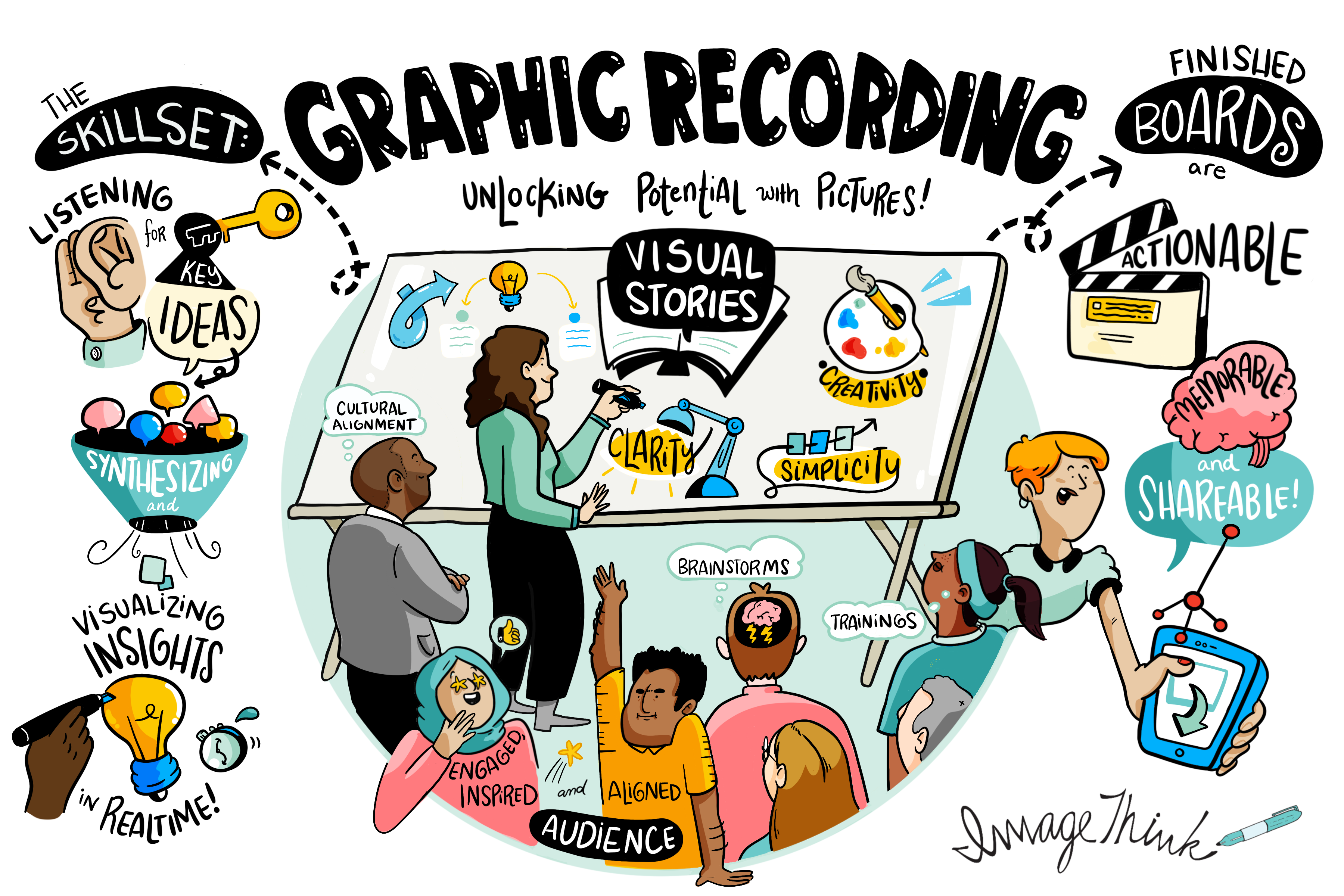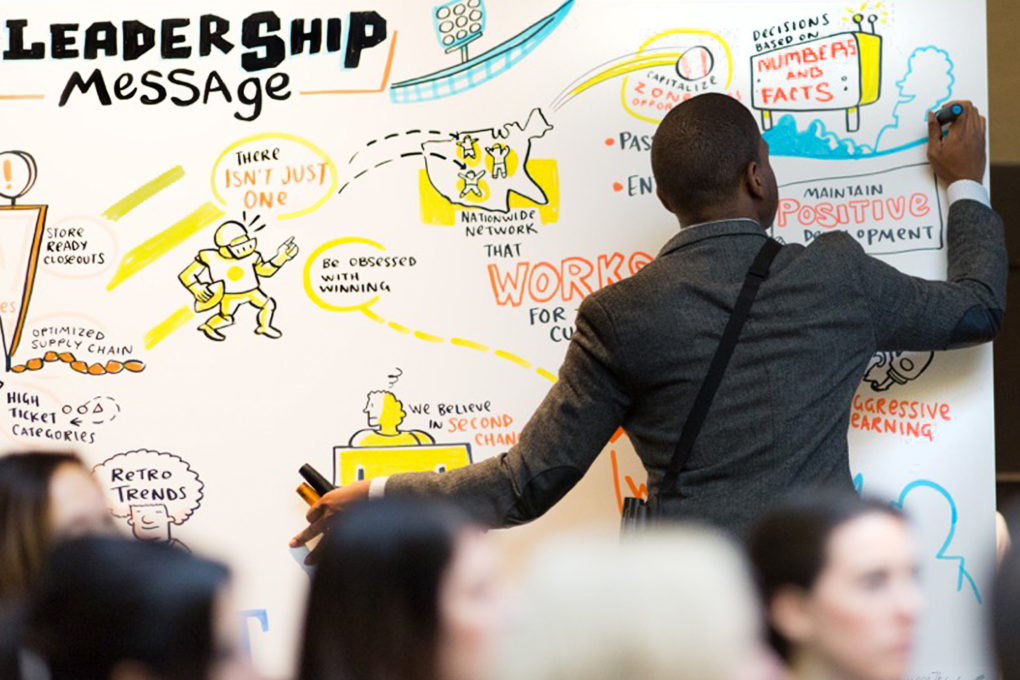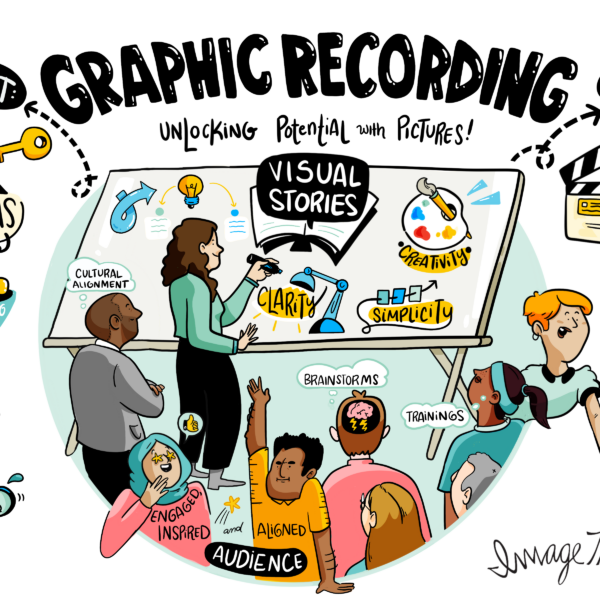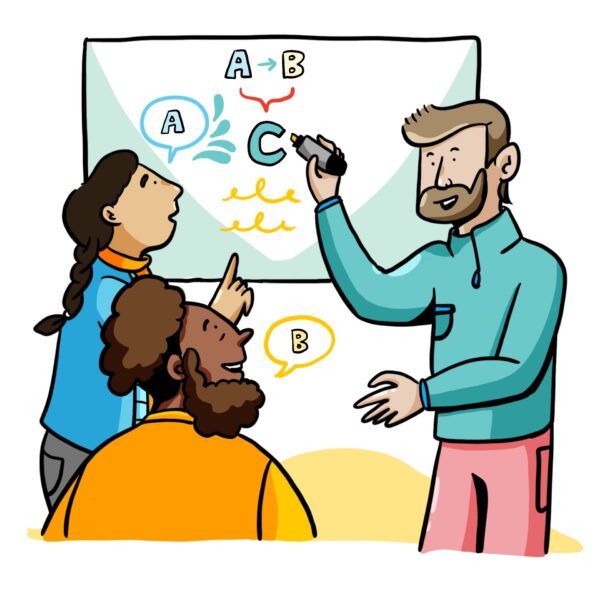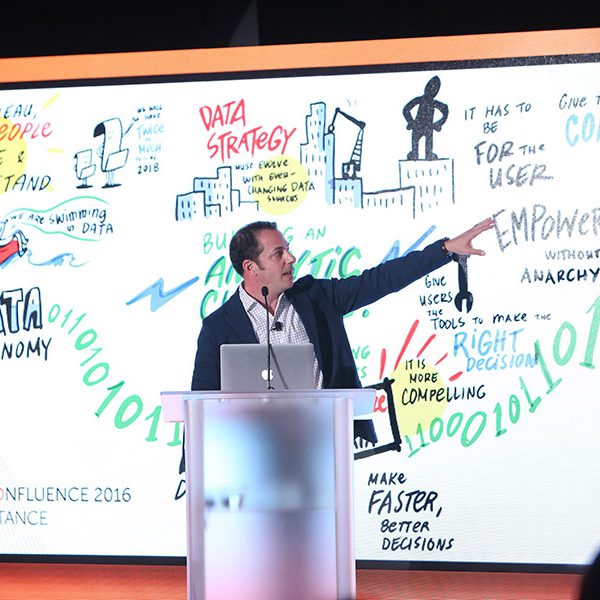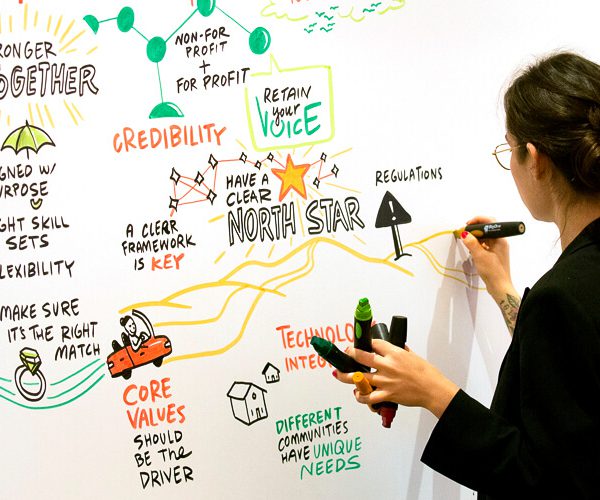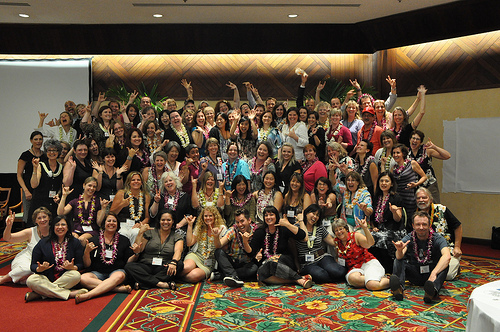ImageThink is a prominent firm in the field of visual strategy, offering visual services like graphic recording, graphic facilitation, and strategic visualization. This article serves to provide an in-depth explanation of graphic recording. In it, we highlight the advantages of working visually and answer frequently asked questions about the service.
What is graphic recording?
Graphic recording is the instant translation of discussions or presentations into text and imagery. Unlike other mediums, this engaging, visual format provides a unique way for attendees to absorb and connect with content.
Graphic recorders simultaneously execute three functions: they listen for key ideas, synthesize them, and visually represent them. In doing these functions, graphic recorders produce visual summaries of key insights in analog or digital format.
Who should use graphic recording?
In our experience, our clients’ roles span from executive level, to directors, to HR or operational, to meeting facilitators. However, anyone can benefit from using a graphic recorder.
Visual notetaking is a tool ImageThink uses to help clients think and work more creatively. It creates better meetings, meaningful engagements, and generates better business outcomes. Real-time capture, synthesis, and visualization of ideas increases engagement, builds team alignment, and ignites creativity.
According to research, 60% of the population self identifies as visual learners. For these individuals, visual aids such as images, diagrams, and charts are essential for learning and retainment. Organizations can embrace visual learners by integrating powerful tools like graphic recording into their work.
Benefits of graphic recording
- In a presentation, graphic recording increases engagement and memory-retention. The real-time translation of ideas into visual metaphors draws viewers in and enables them to absorb content.
- During a brainstorm or strategy session, a skilled graphic recorder transforms group ideas into clear visual representations. Visual capture highlights connections and synergies, enabling attendees to explore and expand on ideas in greater depth. Visualization promotes creative thinking, participation, collaboration, and deeper engagement.
- At a tradeshow or conference, graphic recording adds a human element to branding, marketing, and booth design. It captivates event participants with visual depictions of ideas and messages. It can even provide an interactive element by soliciting and capturing insight from attendees.
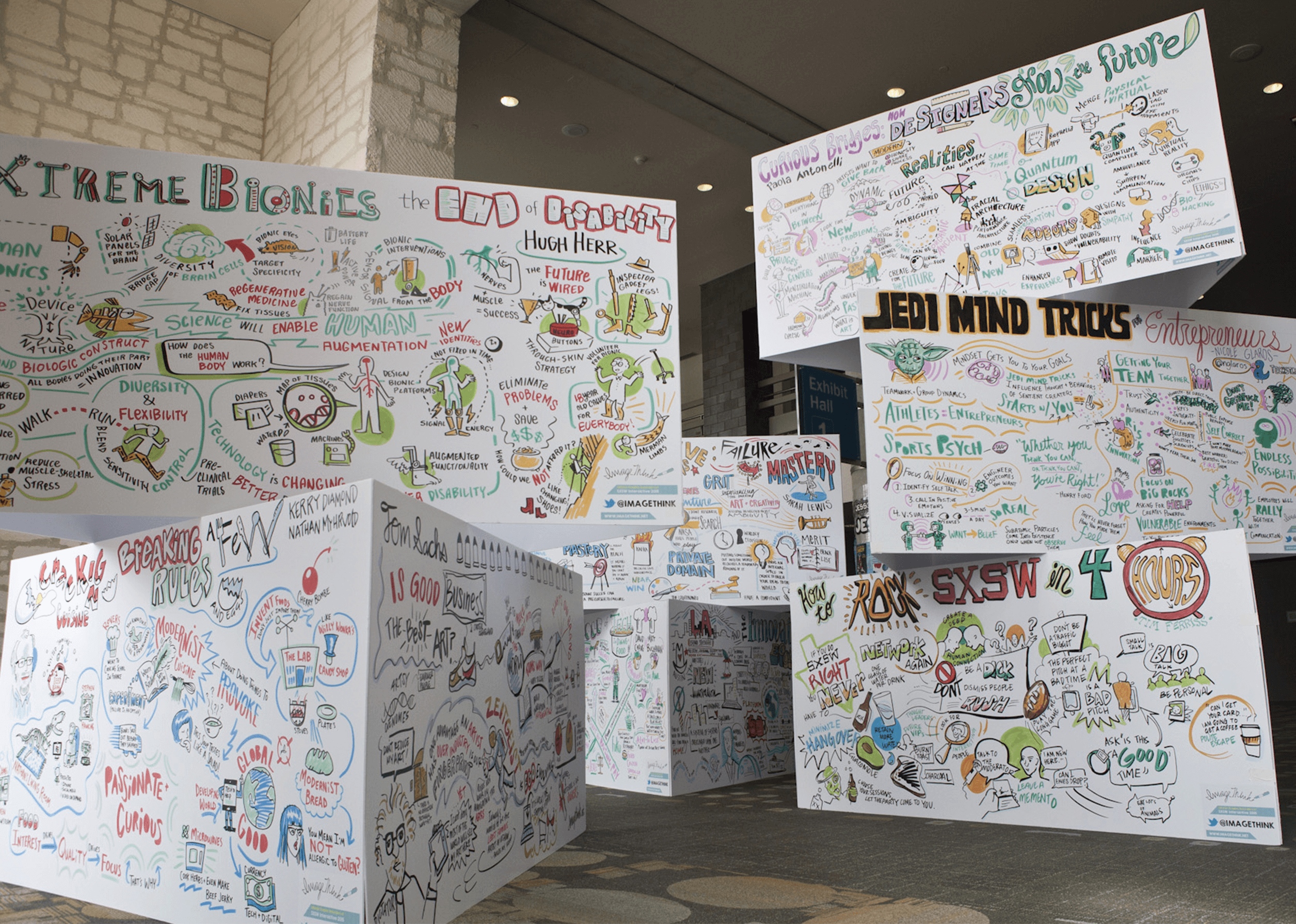
What medium do graphic recorders use?
Graphic recording traditionally takes on an analog or digital form and occurs on large-scale surfaces. These surfaces can include foam-core boards, whiteboards, bond paper, or even digital displays or screens.
In analog format, graphic recording happens in-person. Graphic recorders capture and display visual notes on foam-core board or paper at meetings or events. In addition to these physical assets, you also receive high resolution digital images of the final product.
As a subset to ImageThink’s analog work, we also work on white boards. Whiteboards are large, smooth surfaces ideal for writing, drawing, and brainstorming. They are common to offices, classrooms, and meeting rooms, and provide a sound backdrop for digital notes.
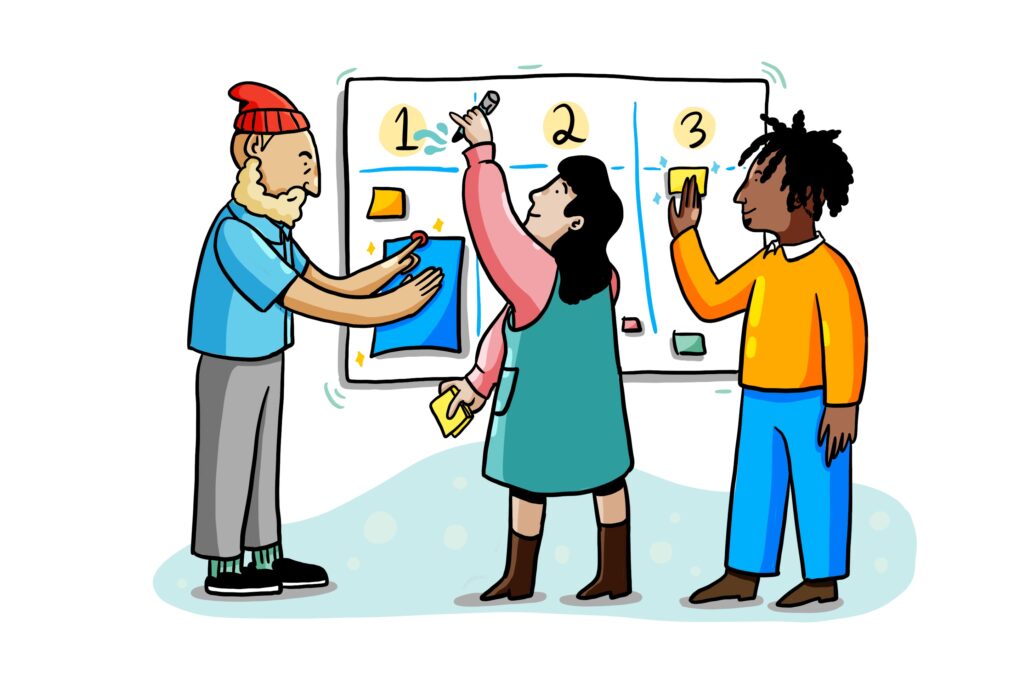
Whiteboarding refers to the act of using a white board to visually communicate ideas, concepts, or plans. This can involve writing out lists, drawing diagrams, or creating charts. Whiteboarding allows for quick changes and updates to the content on the whiteboard. Overall, whiteboards and whiteboarding are valuable tools for collaboration, communication, and creativity.
As an alternative to analog materials, digital graphic recording offers a modern visual approach. Digital capture produces sleek visuals that reach projections of any scale. Perfect for large, or dispersed audience, these digital notes can be streamed or shown in multiple rooms simultaneously.
Digital notetaking enables the immediate share of assets to attendees or to social media channels. This allows you to reach online audiences and grow discussions online.
Education and certification for graphic recorders
More than a meeting artist, a graphic recorder possesses skills in drawing, composition, and visual fluency. Yet, they hold no certification – it is a profession acquired through experience and fine tuning of the craft.
Currently, there is no institution that offers formal education or certification to become a graphic recorder or graphic facilitator. This leaves prospective clients with little formal guidance on how to evaluate the experience and expertise of practitioners.
Graphic recording rates vary from practitioner to practitioner and may also depend on the event type or location. However, there are a few things to look out for when choosing your graphic recorder to ensure the best experience and result.
6 questions to ask when hiring a graphic recorder
1. What is their experience and background?
Unlike many other professional services and consultants, there is no formal educational training or certifications for graphic recorders. Be sure you are hiring an experienced practitioner with a reputable list of past clients.
2. What types of events are they capable of supporting?
Graphic recording should always be tailored to the specific event and its unique objectives. Are you holding a brainstorm session where conversation is open, unstructured, and fast moving? An event consisting of keynote presentations or panel speakers? Make sure your graphic recorder has the skillset to support your session type.
3. What does their fee include?
Pricing structures vary – be sure to inquire how they bill. Is it a day rate or hourly charge? Are materials and travel included? What about the digital versions of the images?
4. Who will be working onsite?
The majority of graphic recording artists are solo practitioners, and oftentimes will subcontract to other individuals. Be sure you know who will actually be supporting your event. Inquire about their level of experience in graphic recording and in your industry.
5. What does the engagement truly entail?
A seasoned graphic recorder or graphic facilitator will collaborate with you during the planning stage of your engagement. They should provide professional advice and guide the integration of the service into your meeting or event. To define the scope of the engagement, inquire about logistic, such as material delivery and shipping.
6. What business liability insurance do they carry?
Some sessions are highly confidential and involve business strategies or trade secrets. For your protection, be sure whomever you are speaking to is bonded, insured ad is willing to sign an NDA.
Understanding the role of a graphic recorder
An experienced graphic recorder is an excellent multitasker, fluid thinker, high level synthesizer, and visual problem solver. A seasoned visual notetaker possesses knowledge of multiple industries, business environments, cultures and behavioral and organizational psychologies, and design thinking.
At any engagement, a graphic recorder employs active listening and real-time synthesis. They must recognize and map key ideas into mind-maps or visual metaphors that clarify the flow of information.
Steps to becoming a graphic recorder
At ImageThink, every graphic recorder goes through intense training to improve their visual notetaking and graphic facilitation skills. ImageThink’s training program includes many hours of hands-on practice, workshops, and feedback. This ensures that each individual has the tools and techniques needed to quickly synthesize and visualize ideas.
During training, graphic recorders learn how to quickly learn and practice the acts of listening, distillation, and visual translation. In this process, they develop drawing and storytelling abilities. They also cultivate their understanding of visual language and design principles.
At completion of ImageThink’s training program, graphic recorders are adept at capturing and organizing information, and facilitating engagements.
Our commitment to training and development sets ImageThink apart as a leader in the field of visual strategy. Investing in the development of our graphic recorders is a benefit to our clients, and also contributes to the growth and success of our company. When you work with ImageThink, you can rest assured. You are partnering with highly trained, dedicated professionals who will help you achieve your goals through the power of visual thinking.
Ready to picture your big ideas?
Now that you know about ImageThink’s core service, are you ready to elevate your next big engagement? Get in touch with us today to capture your next meeting, event, or project.
Frequently asked questions
Visual recording, also known as visual note-taking or graphic recording, involves capturing ideas in real-time by drawing simple words and pictures. These visuals serve as metaphors to represent complex concepts, making them easier to understand.
A graphic recorder converts concepts, discussions, and presentations into visually engaging and memorable graphics. Whether it’s a complex strategy session or a dynamic keynote speech, they distill information into meaningful and easy-to-understand visuals.
A graphic facilitator is a professional trained in using visual imagery to aid communication and collaboration. They listen to conversations, synthesize complex ideas, and create clear visual representations that help groups comprehend and retain information.
People use graphics because they create a stronger first impression. In digital marketing, content with relevant images gets 94% more views than content without them. Given our short attention spans, visuals are crucial for capturing and maintaining audience engagement.
Graphics enhance visual communication by arranging essential information clearly and making it easier to understand. They demonstrate a commitment to effective communication with customers, reflecting the same level of attention to your products and services.
